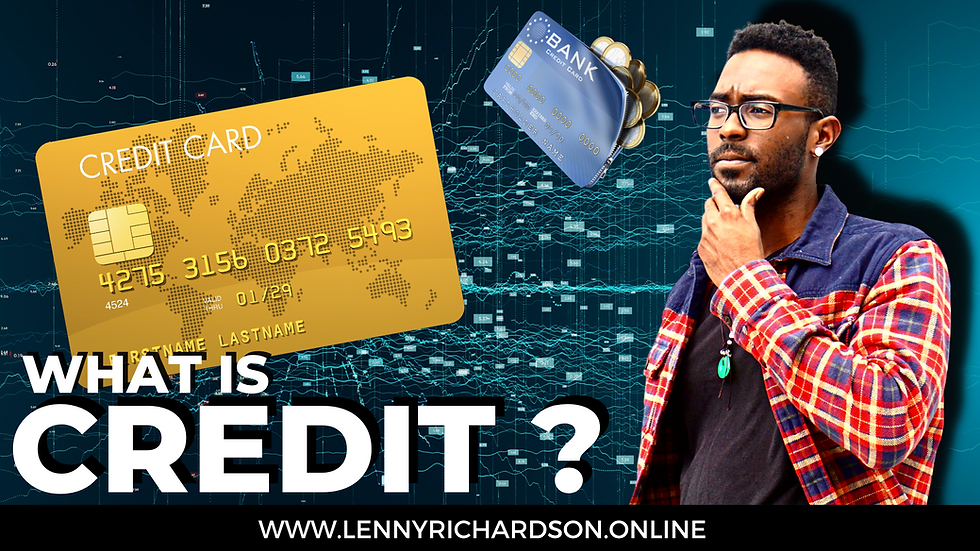How to open your first credit card
- Lenny Richardson
- Sep 11, 2022
- 7 min read

Introduction
If you don’t have a credit card, get one. ASAP. Like, right now! Credit is a vital tool to have in your arsenal. I’ve discussed in previous articles such as the What is Credit Composed Of and the What is Credit articles, credit will offer major advantages in life when used correctly. This article is to walk you through exactly how to open up to your very first credit card.
Consider your spending habits
Credit cards are not for everyone. If you use your credit card and pay off the balance every month, great! But if you don't pay off the balance in full each month, that could negatively impact your credit score and leave you with high interest rates on unpaid balances.
Credit cards aren't a "free lunch" — they're not free money from someone else's bank account. Credit is a loan that needs to be repaid over time or immediately.
Open a Credit Card with a Parent/ Relative
This is the simplest way to open a credit card. Many people often have a cosigner in the form of a parent, guardian, or relative that will enable them to open their very first credit card.
Understand that when using this tactic, any debt that isn’t paid hurts the cosigner. So, to put it simply, if a parent cosigns to help you open up a credit card, not paying the card’s balance on time can affect their credit score poorly.
Open a Secured Credit Card
Opening a Secured Credit Card is an excellent option for someone without access to a cosigner or for someone that wants to take full responsibility for their credit. Personally, I recommend this option if this is your first credit card as it’ll get you familiar with how credit cards operate and will help you build up experience overall.
Below are the steps to Opening a Secured Credit Card
1. Save $250-$750
First, I suggest saving anywhere from $250 to $750. A secured credit card requires you to put money down to activate the card. The money you put down will act as your credit limit. In situations in which you can’t pay of debts over a long period of time, your initial deposit is forfeited. The money you save will act as this initial credit card limit.
2. Request a Secured Credit Card
At a bank of your choosing, request a secured card. You’ll likely need to go to bank in person for this. Also, you might need to have a checking account already active at the bank you choose so keep this in mind.
3. NEVER overspend and use your credit card frequently
Now that you’ve opened your Secured Credit Card, it’s best to be as responsible as possible with it. DO NOT overspend and hit your limit. And always pay the balance back in full immediately after buying anything.
As a side note, I personally recommend using your credit card primarily as spending money with most credit cards provide perks and benefits that you wouldn’t get from a debit card. With a secured card, you probably won’t get these perks and benefits but it helps to build up this habit.
4. After a year, request to upgrade your secured credit card to an unsecured credit card
Continue to use your secured credit card wisely. After a year, request to upgrade your secured credit card to a standard credit card. Typically, this first card will offer some of the aforementioned perks and benefits.
5. Enjoy being a responsible credit card carrier
Do not begin to fall into bad habits. Only spend what you can afford. And, as a general rule of thumb, if you can’t buy it three times you can’t afford it once. At this point, you’re on your way to building up your credit. I highly recommend checking out my FREE Basic Finance Course to get more in-depth on insights you can use to maintain healthy finances. Also, be sure to check out the other finance guides on the website.
6. BONUS: Inquire to increase your Credit card limit yearly (This can be done usually online but may require a phone call)
This is a hack I highly recommend implementing. As I mention in my What is Credit Composed of article, Utilization makes up a large part of your credit score. In fact, it makes up 30% of your score.
A way to keep your Utilization low is to request an increase in your credit card limit frequently. I recommend doing this each year on every card. I’d also spread out the requests per card. So, for example, if you have 3 credit cards I’d recommend increasing the limit of the first card at the beginning of the year in January, the second around June, and the last card around October.
The reason for this is because your card issuer will typically make an inquiry on your credit report. An inquiry will temporarily lower your credit score and this can cause you to be denied for a credit limit increase.
Avoid overspending
If you're going to use a credit card, you need to make sure that you're spending within your means. If you don't pay off the balance every month, it can rack up interest charges and become an expensive bill.
Credit card companies aren't charities; they expect the money back. If they don't get it, they'll raise your rates or close your account—and either way, it can damage your credit score. So if you have debt on a credit card already and don't have the money to pay it off right away, or if paying off debts with high interest rates is causing problems for other aspects of your life (like mortgage payments), consider transferring some of those balances onto lower-interest cards so that they can be paid down faster.
Keep tabs on your credit scores
You'll want to check your credit score at least once a quarter and make sure it's in good shape.
You can do this for free by visiting annualcreditreport.com, which provides a free report from each of the three major credit bureaus (Equifax, Experian and TransUnion).
I also recommend using Credit Karma, which frequently shows you general credit scores and updates you on any activity to your credit report. I’d suggest enabling push notifications on Credit Karma and downloading the app on your phone to allow you to stay up to date on your credit health with little hassle.
Regardless of whether or not you use any of these services on an ongoing basis, remember that as long as there are no errors on your report, your score should be relatively stable over time—unless something significant happens in your life that affects how lenders view your ability to pay off debt responsibly (e.g., losing a job).
Don't leave balances on the card from month to month
While it's tempting to use your new card for everything, don't leave balances on the card from month to month. As you pay down the balance each month, you'll also help establish a history of making payments on time. A good way to keep track of how much you're charging is by using a monthly statement or checking account summary that lists purchases in order by merchant and amount spent.
It's important not to use more than half of your credit limit—doing so may make it look like you have high levels of debt compared with other people with similar income levels, which could negatively affect your score. Your goal should be keeping utilization under 30%, according to one FICO study. If this seems hard at first, start by trying not to go over 50%. If possible, your best strategy is to stay under 10%.
Finally: Don't feel afraid asking for lower interest rates down the road! Credit cards are designed so that rates will go up if left unchanged for several months or years at a time; request lower rates now before they happen automatically!
Limit opening several cards at once
While it’s tempting to go for the gold and try to open more than one card at once, the best thing you can do is keep things simple. When applying for a new card, don't apply for more than one at a time—you don't want your credit score getting confused by multiple inquiries on your report. It's also important not to apply for cards from the same bank (i.e., Bank of America) unless you have a good reason, such as needing access to an exclusive rewards program or having a small business relationship with them already.
Finally and most importantly: Don’t apply for multiple cards from the same bank in the same month—it's just not worth it!
CONCLUSION
You do want a credit score. Know how to build it and use your first card to build it.
Your first credit card will be used to build your credit history and profile. It is the beginning of a long-term relationship between you and your bank or lender. As you use this card responsibly, over time, your lender will become more willing to extend you larger lines of credit on better terms as well as offer new products such as car loans or mortgages. You’ll also earn rewards points that can be redeemed for cash back, travel miles or merchandise from participating retailers like Amazon or Best Buy.
After all, would you want to own a home without owning any property? Or buy a car without having any auto insurance? Your lack of experience with these things would make them far more risky than if someone else had already done all the trial runs for you!
FOLLOW LENNY
On Instagram: https://www.instagram.com/leviticusrich/
Improve your Life: https://www.lennyrichardson.online/programs
Grab a Copy of Lenny’s book How I Fvcked Up here: How I Fvcked Up Book on Amazon
Free Weekly Insights, Tips, and Practical Tactics for a Better Life: Sign Up Here
Please share this article with someone that can benefit from this.
Also, if you’re interested in taking your day to the next level and learning the strategies used by top-level performers to maximize their day, click here.




Comments